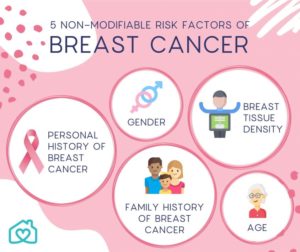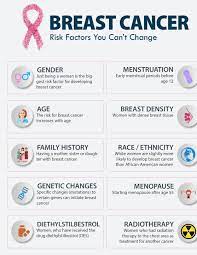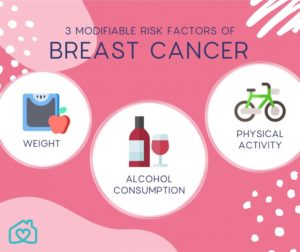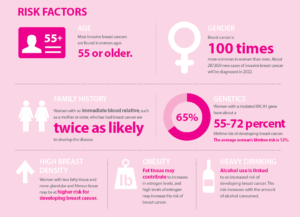Non-modifiable risk factors to breast cancer means factors we cannot change:
Modifiable risks risk factors to breast cancer. This means factors we can control:
Weight. Being overweight is associated with increased risk of breast cancer, especially for women after menopause. Fat tissue is the body’s main source of estrogen after menopause, when the ovaries stop producing the hormone. Having more fat tissue means having higher estrogen levels, which can increase breast cancer risk.
Diet. Studies are looking at the relationship between diet and breast cancer risk and the risk of recurrence. The Women’s Health Initiative Trial suggested that a diet very low in fat may reduce the risk of breast cancer. More research is needed in this important area for women who are interested in eating well to reduce their risk of ever getting breast cancer.
Diet pretty much affects your weight. Unless you have a high metabolism or are severely active eating fattening foods will put on weight.
In the meantime, here’s what dietitians suggest:
- Keep your body weight in a healthy range for your height and frame. Body mass index, though not a perfect measurement, can help you estimate your healthy weight.
- Eat plenty of vegetables and fruit (more than 5 cups a day).
- Try to limit your saturated fat intake to less than 10% of your total calories per day and limit your fat intake to about 30 grams per day.
- Eat foods high in omega-3 fatty acids.
- Avoid trans fats, processed meats, and charred or smoked foods.
You’ll find that processed foods generally don’t fit in this type of diet as well as fresh foods do. For more information, visit our page on healthy eating to reduce risk of breast cancer in the Nutrition section.
Exercise. Evidence is growing that exercise can reduce breast cancer risk. The American Cancer Society recommends engaging in 45-60 minutes of physical exercise 5 or more days a week.
Alcohol consumption. Studies have shown that breast cancer risk increases with the amount of alcohol a woman drinks. Alcohol can limit your liver’s ability to control blood levels of the hormone estrogen, which in turn can increase risk.
Smoking. Smoking is associated with a small increase in breast cancer risk.
Exposure to estrogen. Because the female hormone estrogen stimulates breast cell growth, exposure to estrogen over long periods of time, without any breaks, can increase the risk of breast cancer. Some of these risk factors are under your control, such as:
- taking combined hormone replacement therapy (estrogen and progesterone; HRT) for several years or more, or taking estrogen alone for more than 10 years
- being overweight
- regularly drinking alcohol
Recent oral contraceptive use. Using oral contraceptives (birth control pills) appears to slightly increase a woman’s risk for breast cancer, but only for a limited period of time. Women who stopped using oral contraceptives more than 10 years ago do not appear to have any increased breast cancer risk.
Stress and anxiety. There is no clear proof that stress and anxiety can increase breast cancer risk. However, anything you can do to reduce your stress and to enhance your comfort, joy, and satisfaction can have a major effect on your quality of life. So-called “mindful measures” (such as meditation, yoga, visualization exercises, and prayer) may be valuable additions to your daily or weekly routine. Some research suggests that these practices can strengthen the immune system.
The National Cancer Institute estimates an outstanding 80% of cancer in America is do to our lifestyles particularly DIET and EXERCISE. That includes Breast Cancer. I am not saying it is the only reason but a large percentage has to do with it and with changing it to a healthy one if your diet is not already including your exercise it lowers the probability for a large amount of people in America from getting cancer. This principle also pertains to many other diseases (Ex. Obesity, High blood pressure, Diabetes, etc…)
Breast cancer is a polygenic and multifactorial disease for which estrogens have been recognized as the main risk factor, and for which lifestyle plays a key role. Previous epidemiologic cancer research performed in Uruguayan population delimited its dietary and anthropometric profiles (use for identification, use for the purposes of understanding human physical variation and in various attempts to correlate physical with racial and psychological traits). Recognizing the difficulty for universalizing a nutritional basis for prevention due to different eating patterns among regions and countries, what was summarized was the existent knowledge linking nutrition, estrogens, metabolism and Breast Cancer. As an attempt towards primary prevention of Breast Cancer, present recommendations mainly based on country-specific research findings and modifiable putative risk and protective factors, proposing to modify the intake of meats and other fatty foods – especially sources of Ω-6 and Ω-3 fatty acids – adding olive oil, selected vegetables, citrus fruits and working towards adequate body fat/muscle proportions. From a medical and ethical viewpoint, it is justified to recommend certain nutritional changes to women, because no adverse side effects are expected to occur.
There is evidence for an inverse association between physical activity and breast cancer risk. The evidence is stronger for postmenopausal breast cancer than for premenopausal breast cancer.
The National Cancer Institute states 80 percent of all cancers is due to our lifestyles. For some who are already active and eating healthy your already ahead of many in prevention of cancer but for those who don’t you dramatically alter your risks going towards higher probability of possibility getting cancer. If your one of those people I have great news this risk is controllable and you can fix it.
The modifiable risk factors are ones like your eating and exercise, which you have full control of. I am not saying become a weight lifter or workout in a gym 4 x/wk if you don’t now. What I am saying is increase your activity with some exercise like walking a mile a day or what you can tolerate and increase your exercise overtime. If you get yourself up to 2 to 5 miles a day, great! If you become a regular at the gym or weight lifter great but you don’t have to go to that extreme of being a Sylvester Stallone or Rocky.
Non modifiable+modifiable risk factors:



